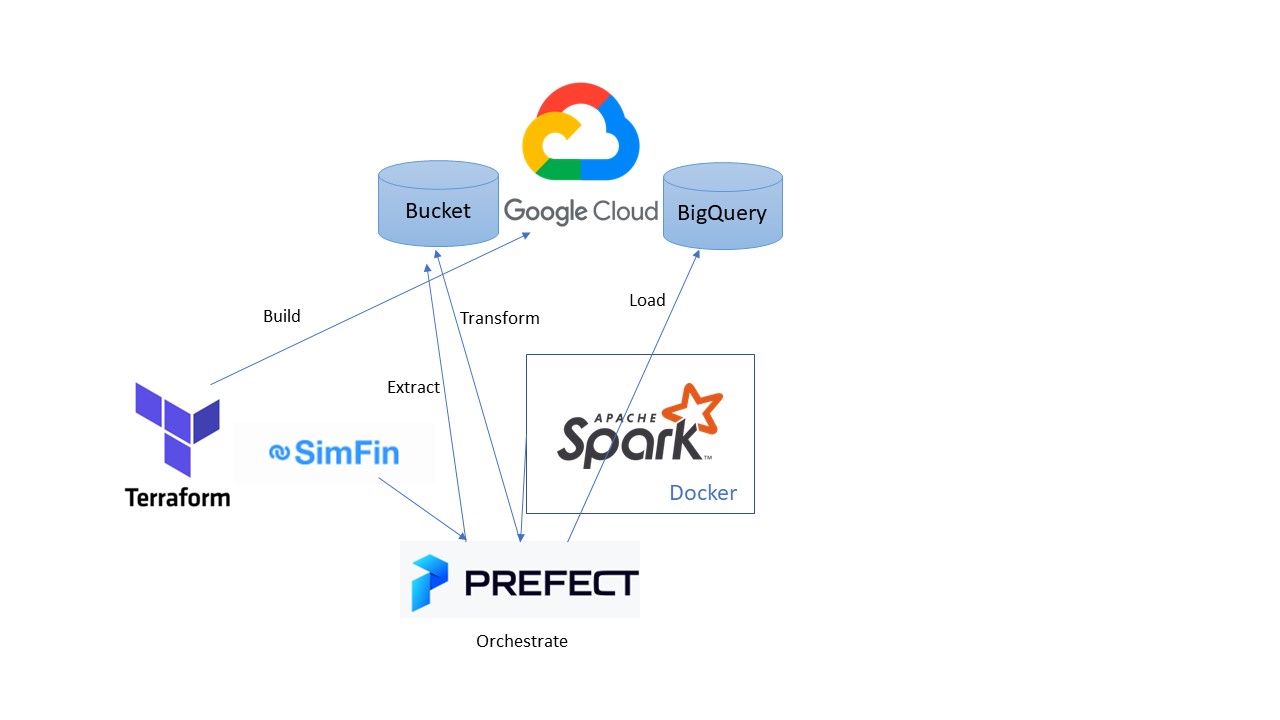This repository contains my capstone project for the amazing Data Engineering Zoomcamp course (2023 edition).
The goals of the project are:
- Collect finantial data from the US stock market (Extract).
- Process the finantial data to generate derived quantities for further analysis (Transform).
- Save the transformed data in Big Query (Load).
- Orchestrate the full pipeline using an orchestration tool.
- Generate a report summarizing some of the findings.
We have used the following technologies:
- Terraform for generating all the needed resources in Google Cloud.
- Prefect for orchestrating the whole data pipeline.
- Spark for transforming the data.
- Docker for simplifying the installation and usage of Spark.
- Google Cloud Storage as a Data Lake.
- Big Query as a Data Warehouse.
For reproducibility, the PC must have installed Docker, Python (at least 3.8), git and Terraform.
After that, just clone the repository:
git clone https://github.com/JaimeArboleda/de-zoomcamp-capstone.gitFor reproducibility, other tools and accounts are needed:
- Google Cloud account with a project.
- Prefect Cloud free account.
- Simfin free account (for downloading the data).
One of the objectives (albeit not explicitily stated) is to achieve as much automation as possible, without repeating configuration options everywhere (that is, applying the DRY principle). In order to achieve this goal, the only configuration steps (after cloning the repository) that are required are:
-
Download a JSON credentials file from GCP and place it at the root of the repository named
gcp_credentials.json. -
Create a file named
.pyenvat the root of the repository that will contain all needed configuration. This file must have the following content:sim-fim-api-key=<YOUR-API-KEY> project-name=<YOUR-GCP-PROJECT-ID> bucket-name=<YOUR-BUCKET-NAME> region=<REGION-FOR-GCS-AND-BQ> storage-class=STANDARD # This value should be ok dataset-name=<DATASET-NAME>
The only two fields that cannot be freely choosed are the first two. The rest can be freely specified.
-
Create a virtual environment and install the requierements:
python -m venv venv pip install -r requirements.txt
For this task we rely on terraform. We have found a useful trick that allows us to use the .pyenv file instead of duplicating the information. In the file variables.tf, we read the configuration file and load it into a dictionary of variables:
locals {
envs = { for tuple in regexall("(.*)=([^\\n\\r]*)", file("../.pyenv")) : tuple[0] => tuple[1] }
}In order to create the resources, just two commands need to be executed:
cd terraform
terraform init
terraform apply
You can view the source code here and here.
You need to have a prefect cloud account and to log in in your terminal using the virtual environment (that will have prefect installed). You can follow the instructions here.
After that, just run the following commands:
prefect block register -m prefect_gcpThis will register the GCP blocks that are used in the project.
python ./init_blocks.pyThis will create all the blocks automatically using the configuration defined in .pyenv and the credentials file.
You can view the source code here
Just run the following command:
python ./flows/extract.py
The extract flow is a simple flow that uses simfin library for retrieving finantial data (three datasetes are obtained) and saves the results as parquet files in a Bucket in GCS.
You can view the source code here
The transformation flow uses Spark. It's a simple flow and the data volume does not justify the use of Spark, but in general, in real settings with big data volumes, it will make much more sense.
To run the flow, just run:
python ./flows/transform.py
However, this flow (that can be examined here) does not contain the Spark code: it just run shell commands with two objectives:
- Spin up the container that has a Spark Cluster.
- Run (
spark-submit) the corresponding job.
To see the Spark code you can view this file.
It's also worth taking a look at the Dockerfile. It's based on an official image with PySpark and JupyterLab, but it contains two useful additions: a jar file that adds capabilities to Spark for interacting with GCS (reading/writing files) and two libraries that are used (dotenv and google-cloud-storage).
In this step, the Spark code reads the files from the Bucket, perform the transformation step and writes them back to the Bucket. It's worth mentioning that this step is (like the rest of the flows) idempotent (you can safely execute it several times). Besides, only the data that is fresh will be recomputed and overwritten (the processed files are separated by months in order to achieve this).
Run:
python ./flows/load.py
In this step, whose code is available here, an external table (obtained from all parquet files) and a materialized version of it are built in Big Query.
The final report (made with Locker Studio by Google) is available here.
A pdf version can be downloaded as well, just in case when the free account is cancelled the report stops working.
